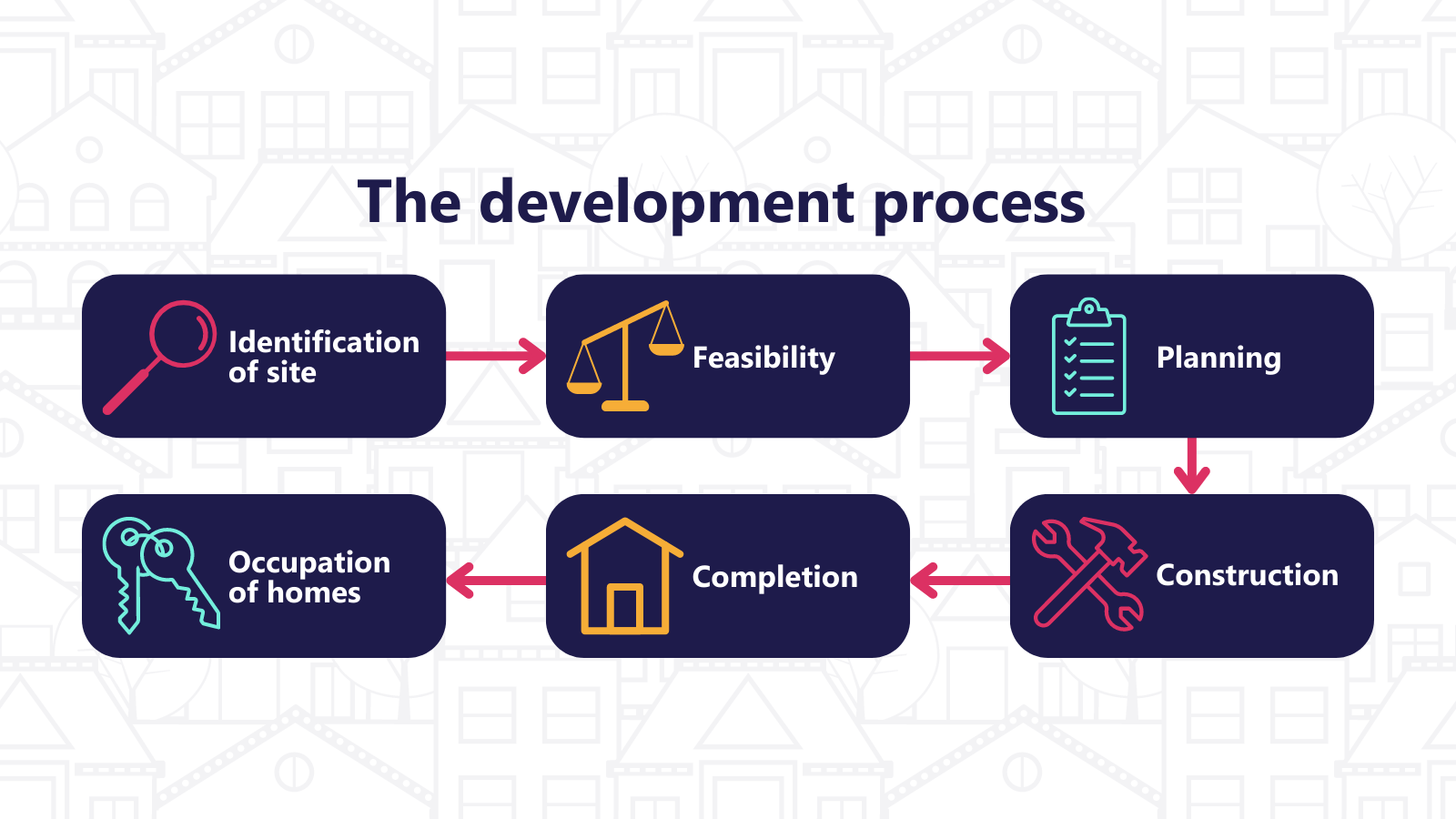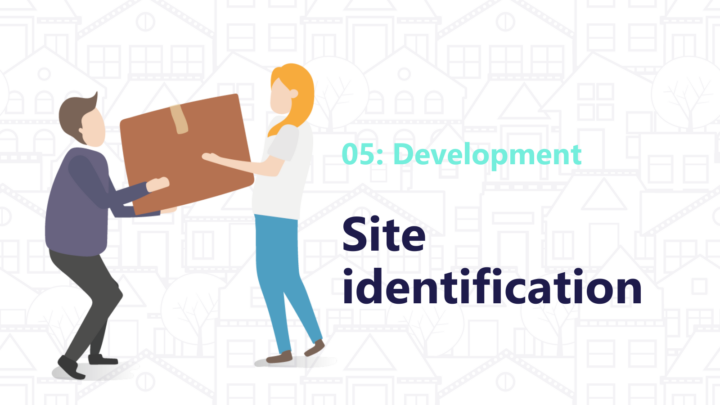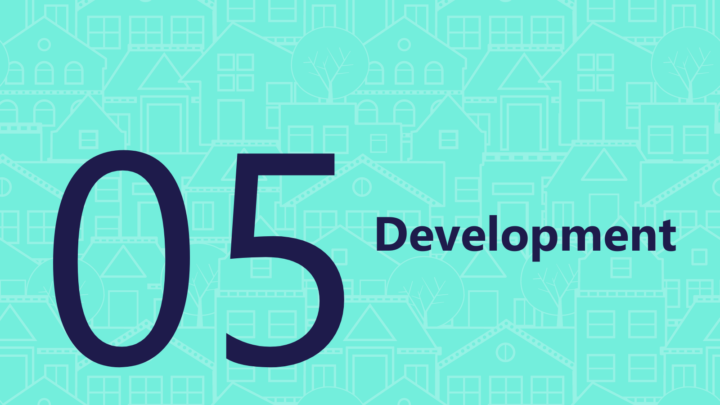Development process


Differing stages will have differing timescales and degrees of complexity but broadly the stages are categorised into two areas of activity which apply irrespective of whether the development is a newbuild scheme or the purchase and refurbishment of an existing property:
Pre-contract stage: This comprises those essential and important activities and milestones necessary to appraise the site through technical, legal, planning and commercial or financial due diligence and includes the purchase of the site or property, detailed design work, securing planning consent and the procurement of construction works.
Post-contract stage: This comprises those activities associated with construction or building works including the completion, commissioning, handover and occupation of the new homes and post-occupation monitoring and evaluation.
Throughout the whole development process and at each of the pre and post-contract stages, there will be a series of milestones or approvals. These are fundamental and necessary gateways within the development process and will include statutory approvals such as planning consent as well as funder approvals and governance approvals of the group or organisation commissioning the development project. Similarly, at differing stages of the process, different members of the project team will adopt differing roles in leading certain aspects of the process, as determined by the resources, skills, knowledge, experience and expertise needed by the activities and stages.
The development process is characterised by a strong focus and underpinning approach around risk management whether it be technical, financial, operational, health and safety, or reputational risks. Furthermore, the process requires teamwork between clients, consultants, contractors and other organisations who will all contribute to the success of the development project, and all will need to demonstrate the resilience, tenacity and determination to succeed in bringing to fruition the vision and aspirations of community-led housing projects. Finally, the process and its success will be determined by the preparation and confirmation of a clear project brief which will outline the ‘why, what, how and when’ of a project within the financial and other resources available to deliver the project.
There are many and various participants in the development process whether they be individuals, groups, communities, organisations or businesses, and statutory bodies. These can be summarised thus:
• Developers, e.g. CLH groups, private sector, housing associations
• Local authorities
• Funders – public and private
• Landowners
• Clients or commissioners
• Consultants
• Contractors
• Utility services
• Communities
These groups include internal and external stakeholders in the process and may perform different roles and functions at different times during the development process whether as the promoter of a project, a funder, a statutory body or an organisation providing a service or undertaking construction works.
However, the key role is that of the community and again the community will take on many and various roles of both a formal and informal nature and which include:
• Grassroots innovator, pioneer, champion
• Campaigner and policy ‘shaper’
• Stakeholder
• Consultee
• Founder and trustee/member
• Client
• Developer
• Contractor
• Funder
• Occupier/householder
• Housing manager
• Estate manager
In fulfilling these roles, the key aspect is that it demonstrates the true and fundamental role and ‘ownership’ of the community of a CLH project to create genuinely affordable community homes.
There are a range of options and routes to deliver a CLH project from an organisational perspective as noted in previous sections of this document but also in terms of the physical development of the new homes. These include the following:
• Land-led
• Package deals
• Turnkey Section 106 Agreements
• Enabling developers
• Acquisition of existing properties
It is important to recognise that these options are not exhaustive and that no ‘one size fits all’, as a hybrid approach might be capable of delivering imaginative and innovative solutions to local community circumstances. Nevertheless, there are certain factors and considerations that will support the determination and decision-making around a preferred development option and route. These include:
• Land ownership control
• Control over project roles and responsibilities
• Control over design
• Cost certainty
• Risk appetite and transfer
Risk is the threat that an event or action will adversely affect the ability of the project to meet its stated objectives and its ability to effectively execute the project. Risks can be identified under two key types:
Functional risks: Those that arise from the core activities of the development process.
Cross functional risks: Those that arise due to external factors to the development project, but which can have an impact on its delivery.
The sources of risk within the development process are broadly categorised as:
• Technical
• Operational
• Health and Safety
• Planning
• Legal
• Commercial
• Reputational
To mitigate these risks within the development process requires a series of strategic and practical measures or controls. At the highest level, there is the ‘golden triangle’ of project management related to the time, cost and quality and how these are measured and monitored against risk.
At a practical level, risk mitigation measures include:
• ‘I can deliver the project for’ not ’I hope to build for’ statements
• Preparation of a project brief and avoidance of project ‘scope creep’
• Early warnings
• Design freeze
• Use of standard contract documents and forms of appointment
• Get the ‘right’ people involved
• Pre-development diligence framework
• ‘Test, Test and Test Again’ in terms of design and cost
• Allow time
There are essentially three main roles within the development process setting aside the duties and functions of bodies such as local authorities and funders. These are summarised as:
Client: Whilst in certain instances a client can seek to employ the services of a development agent to act on its behalf, the roles of the client are summarised as:
• Commissioning, sponsoring or promoting the project
• Defining the project brief
• Funding and paying for the project
• Occupying upon completion of building works
Consultants: Defined as a person or organisation that provides professional expert advice and is usually sourced and commissioned from outside of the client organisation. The consultant role will be characterised by:
• Shared expertise and knowledge in a particular field
• Commissioned by the client to assist in meeting objectives
• Design and execution of the project
• Operating to a defined brief on ‘end to end’ basis
• Contributing to technical, legal, planning, and commercial diligence at both pre and post-contract stages
Consultant roles in the development process are many and varied and multidisciplinary with the following schedule identifying some of the key disciplines though this is by no means exhaustive as determined by the particular and specific requirements of the project:
• Architect
• Quantity Surveyor
• Building Surveyor
• Ecologist
• Planning
• Engineer (Civil, Structural)
• Health and Safety (CDM Regulations)
• Legal
• Building Services Engineer
• Landscape Architect
• Topographical Surveyor
• Valuer
• Other specialists e.g. fire safety, acoustics
Contractors: Primary responsibility for the building works to create the new homes whether by new construction works or refurbishment of existing buildings. It is noted, however, that there are circumstances where the community group leading the project undertake all or part of the building works themselves through self-build, self-finish or sweat equity schemes. Similarly, there exist a range of procurement routes and methods when dealing with building works that can be adopted by the client, but which will be influenced by the size, scale, type, nature and complexity of the project as well as the risk appetite of the client. Nevertheless, the roles and responsibilities of the contractor include:
• Resourcing of the ‘build’ – people, materials, plant, equipment
• Day-to-day construction project management
• Day-to-day Health and Safety management
• Contractual obligations to the client as formally documented in the building contract
A simple equation exists in terms of the quality of the client project brief and the quality of both the design and construction of the new community-led affordable homes. It is therefore important that the brief is clear in setting out the vision and requirements of the client which address general and site-specific considerations. Similarly, the brief is likely to be influenced by statutory regulations such as planning and building regulations in addition to any specific standards and requirements of external funders. As such, the brief will be an evolving, dynamic and consultative document in its early preparation before being fixed.
In simplistic terms, the brief is concerned with issues of the site or property to be developed, the design of the new homes and the performance of the new homes and will include some of the following key information:
• Location
• Accommodation
• Dwelling design
• Environmental design
• Legal constraints
• Planning
• Construction standards
• Budget
• Programme
Health and Safety is a priority in most sectors, but in the development and construction industry, workplace safety can be a matter of life and death. With so many risks and hazards on building sites, safety precautions are vital in keeping construction workers out of harm’s way. Clients, consultants and contractors must position construction Health and Safety at the heart of their projects and activities during pre and post-contract stages.
The statistics on construction workers with injuries and health issues demonstrate just how dangerous building sites can be. There are approximately 54,000 non-fatal injuries each year in the construction industry in the United Kingdom, the majority of those involve slips, trips, falls, manual handling, and falls from a height. In addition, the construction industry also sees an average of 41 fatalities a year, with 36 of those being construction workers and 5 being members of the public.
The construction industry is obliged to take note of about 20 pieces of legislation that relate to the health and safety of its workforce, clients and the public at large. There can surely be no other industry that carries out many of its activities in public areas and introduces there the dangers of falling objects, transportation collisions, lifting operations, falls from height and related hazardous activities not only to its workforce but in close proximity to the general public.
The Health & Safety at Work Act 1974 is the primary legislation from which there are a series of regulations that apply to all businesses and industries including construction but there are additional pieces of legislation aimed specifically at the construction industry. This approach recognises the fact that construction is a particularly hazardous undertaking compared with the majority of other industries.
Amongst the most important regulations are the Construction (Design and Management) Regulations (CDM) 2015 which takes a risk management collaborative approach to identifying hazards and ensuring that actions are in place to mitigate identified risks at all stages of the project from briefing to design, construction, completion and management and maintenance of completed homes. Some of the key components of the CDM Regulations 2015 include:
• Planning of works ‘end to end’ at all stages of the project
• Co-operation, co-ordination and communication of the project team
• Risk management
• Duty holders, roles and appointments as defined by the Regulations including client, designers, principal designer, principal contractor
• Resourcing of Health and Safety
• Notifications to HSE, e.g. F10
• Holistic and day-to-day Health and Safety arrangements
The detailed application of the CDM Regulations 2015 is determined by the scale and duration of the building works period and reference should be made to the HSE publication ‘Managing Health and Safety in Construction’: https://www.hse.gov.uk/pubns/priced/l153.pdf












